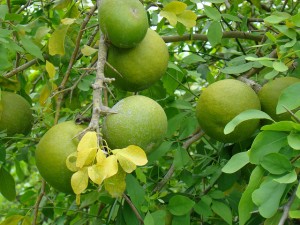Different schools of philosophy have expressed different views about God and creation. While the schools owning allegiance to dwaita philosophy clearly perceive God and creation as separate and distinct entities, the schools of advaita treat the world as illusory and accept only Brahman or Unitary Consciousness as the reality. Philosophically, both schools strive their best to establish their point of view. However, one has to reconcile with the existential world which is clearly perceived and felt by all beings.

Bael or Bilva fruit
Sri Ramakrishna had a wonderful way of reconciling both these philosophies. He used to establish his idea of harmony using a beautiful example from daily life. He would say that the bilva fruit when taken apart is seen to contain flesh, seeds and the shell. Although ultimately the flesh alone is consumed, which is the essential or the most important part, yet one cannot get the proper and full weight of the fruit if one discards the seeds and the shell. One must include all parts of the fruit in the process of weighing. Similarly, he would say that Brahman or Unitary Consciousness is the transcendent or the Ultimate Reality, but the creation cannot be ignored altogether. In other words, what is perceived or felt as creation or the world is in reality nothing but Brahman.
But depending upon one’s stage of evolution in spiritual life, one gets a deeper and higher perception of the reality as one progresses along the path of spiritual journey. That is why Swami Vivekananda used to say that man does not travel from error to truth, but from lower truth to higher truth. While living in the world completely conditioned by the body and mind, it is unrealistic to say that the world is an illusion. It is good to start with the idea that the world is nothing but manifestation of God or Brahman and as one progresses in spiritual life, one ultimately realises that Brahman alone is real.
-by Swami Shantatmananda, 3rd Jan 2015
